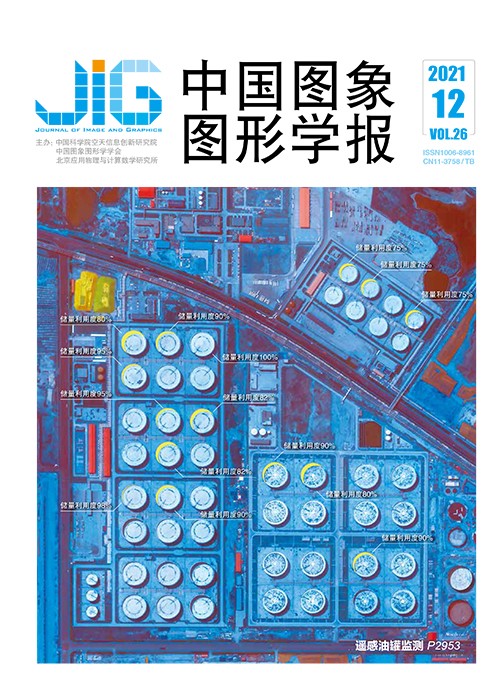
曼哈顿世界环境下消失点非线性优化估计算法
摘 要
目的 符合曼哈顿假设的结构化场景简称曼哈顿世界,具有丰富的场景结构特征。消失点作为直线的潜在观测,是一种全局信息,可以显式地体现载体坐标系与世界坐标系之间的姿态关系。为更加准确地估计消失点,本文针对单目图像,同时考虑实时性和准确性,提出了具有更高精度的基于非线性优化的消失点估计算法。方法 分析目前性能最优的基于随机采样一致性(random sample consistency,RANSAC)的消失点估计方法,通过对直线单参数化、利用正交性约束生成候选假设以及RANSAC过程的重点分析与改进,更加快速准确地得到消失点估计,为后续优化提供初值。利用直线分类时计算的误差度量构建最小二乘优化模型,采用非线性优化方法迭代求解,并采用鲁棒核函数保证迭代的精确性和结果的最优性。结果 通过仿真实验和基于公共数据集的实验对本文提出算法与目前性能最优算法进行比较。仿真实验中,相比于RCM(R3_CM1)及RCMI(R3_CM1_Iter),本文算法结果在轴角形式下的角度偏差减小了24.6%;有先验信息约束时,角度偏差降低一个数量级,仅为0.06°,精度大幅提高。在YUD(York urban city databbase)数据集中,本文算法相较于RCM和RCMI,角度偏差分别减小了27.2%和23.8%,并且80%的消失点估计结果角度偏差小于1.5°,性能明显提升且更具稳定性。此外,本文算法在仿真实验对每一图像帧的平均优化耗时为0.008 s,可保证整体的实时性。结论 本文提出的消失点估计算法,对基于RANSAC的方法进行了改进,在不影响实时性的基础上,估计结果更加准确、鲁棒,并且更具稳定性。
关键词
Vanishing point estimation based on non-linear optimization in Manhattan world environments
Han Bingxin, Lu Huimin, Yu Qinghua, Zhang Lilian(College of Intelligence Science and Technology, National University of Defense Technology, Changsha 410073, China) Abstract
Objective Manhattan world has been an abbreviation for structured scenes that satisfy the Manhattan world assumption, such as artificial indoor and outdoor scenes. It has a strong structural regularity and is in accordance with the Cartesian coordinate system. Manhattan world can be derived that the three dominant directions correspond to the three orthogonal vanishing points. The vanishing point, as a structural feature in the Manhattan world, can explicitly reflect the attitude relationship between the camera coordinate and the world coordinate. In order to use this characteristic of vanishing points to assist visual self-localization, 3D reconstruction and scene recognition, it is of optical importance to accurately estimate vanishing points. A novel and more accurate vanishing points estimation algorithm based on monocular images and nonlinear optimization has been issued. Method First, the current state of the art vanishing point estimation has been analyzed based on random sample consistency (RANSAC). Next, through the analysis and improvement of the single parameterization of straight lines, candidate hypotheses generated using the orthogonality constraints and the RANSAC process, the vanishing point estimates can be obtained more quickly and accurately as the initial value for subsequent operations. At last, the error measurement calculated during line classification has been reused to construct the least squares optimization problem, and non-linear optimization is used to solve it. In order to ensure the accuracy of the iteration and the optimality of the results, a robust kernel function has been used as well. Result the proposed algorithm has been compared with the state of the art RANSAC based method via simulation experiments and experiments based on public database. In the simulation experiment, the angular deviation has been reduced about 24.6% in the form of axial angle compared with RCM (R3_CM1) and RCMI (R3_CM1_Iter) method. When there is a prior information constraint, the angular deviation is only 0.06 degree, decreased by an order of magnitude, which means the accuracy is greatly improved. In the public York urban city database (YUD), the performance of the proposed algorithm has been improved compared with the RCM method and RCMI method. The angular deviation has been reduced by 27.2% and 23.8%. The statistical results have shown that the angular deviation of 80% of the vanishing point estimation results is less than 1.5 degree. In addition, a statistical analysis of the running time has been performed in the simulation experiment. The average optimization time for each image frame is 0.008 s, which can ensure the overall real-time performance. Conclusion The vanishing point estimation algorithm proposed has been more qualified than the RANSAC-based method. The estimation results have shown its superiority in terms of both accuracy and robustness, with no effect on the real-time performance.
Keywords
Manhattan world vanishing point(VP) random sample consistency (RANSAC) nonlinear optimization error measurement
|



 中国图象图形学报 │ 京ICP备05080539号-4 │ 本系统由
中国图象图形学报 │ 京ICP备05080539号-4 │ 本系统由